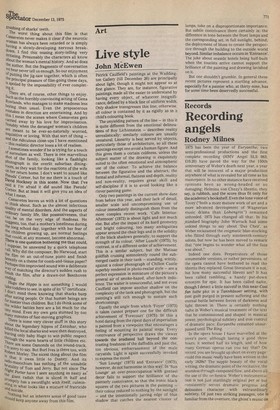Live style
John M-cEwen Patrick. Caulfield's paintings at the Waddington Gallery (till December 20) are principally about light, though it might not appear so at first glance. They are, for instance, figurative paintings, made all the easier to understand by having every object, of whatever insignificance, defined by a black line of uniform width. Only shadow transgresses this line; otherwise all colour is contained by it as rigidly as in a
child's colouring book.
The unyielding pattern of the line — in this it is quite different from the emotional delineations of Roy Lichtenstein — describes reality unrealistically; similarly colours are usually unnatural. Linearity is best served by objects, particularly those of architecture, so all these paintings except one avoid a human figure. And this gives them a certain coldness, unless the subject matter of the drawing is exquisitely suited to the often emotional and atmospheric use of the colour. To achieve the balance between the figurative and the abstract, the formal and informal, flatness and depth, reality and non-reality, requires great skill and self-discipline if it is to avoid looking like a clever painting game. Only two paintings in the current show date from before this year, and their lack of detail, smaller scale and uncompromising use of colour immediately distinguish them from the more complex recent work. 'Cafe Interior: Afternoon' (1973) is about light and not much else. But after the impact of its hard geometry and bright colouring, too many ambiguities appear around the chair legs and in the solidity of the black shadows generally, to support the strength of its colour. 'After Lunch' (1975), by contrast, is of a different order of achievement. This is a similar subject, but the Matisse goldfish cruising somnolently round the submerged castle in their tank — standing, wittily, against a colour photograph of Chinon Castle superbly rendered in photo-realist style — are a perfect expression in miniature of the picture's general air of smoke-hazed, after-lunch indolence. The waiter is unsuccessful, and not even Caulfield can impose another shadow on the complexity of the tank and photograph, but the painting's still rich enough to sustain such shortcomings. Equally the angle from which 'Foyer' (1973) is taken cannot prepare one for the difficult achievement of 'Forecourt' (1975). In this a hotel dating from the ripest days of imperialism is painted from a viewpoint that encourages a feeling of mounting its palatial steps. Every contrivance of perspective draws the viewer towards the irradiated hall beyond the contrasting freshness of the daffodils and past the, too obvious, embarrassment of the male caryatids. Light is again successfully invoked to express the mood. Sun Lounge' (1975) and 'Entrance' (1975), however, do not harmonise in this way. In 'Sun Lounge' an over-preoccuPation with genteel decor fails to support the brilliance of the painterly contrivance, so that the ironic black squares of the two pictures in the painting — their colour reduced to nothing by the sunlight — and the intentionally jarring edge of blue shadow that catches the nearest cluster of lamps, take on a disproportionate importance. But subtle contrivance there certainly is: the difference in tone between the front lamps and the corresponding set, in full sunlight, behind; the deployment of blues to create the perspective through the building to the outside world beyond. Similar imbalance occurs in 'Entrance'. The joke about seaside hotels being half-built when the tourists arrive cannot support the brilliance of the painting and drawing lavished on it.
But one shouldn't grumble. In general these recent pictures represent a startling advance, especially for a painter who, at thirty-nine, has for some time been deservedly successful.

































 Previous page
Previous page